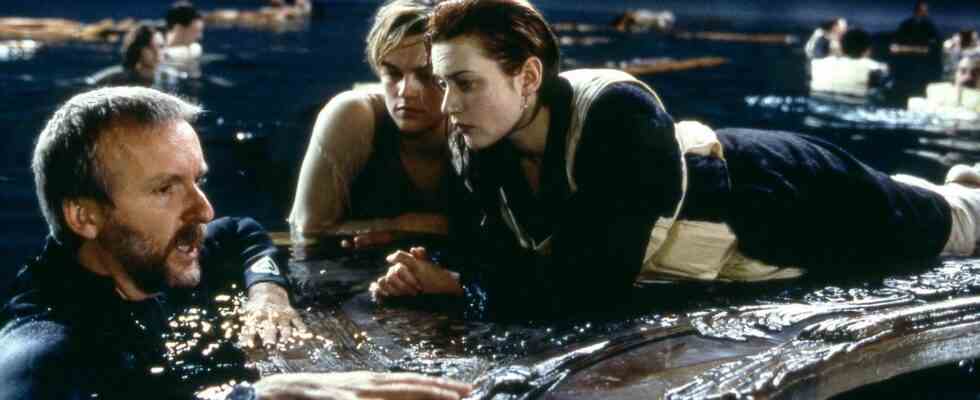Controversy over cult film
‘Rose’s raft should have been smaller’: James Cameron opens up about mistakes in ‘Titanic’
Director James Cameron with his main actors Leonardo DiCaprio and Kate Winslet during the shooting of “Titanic”
© Mary Evans / Imago Images
It’s a question fans have debated for years: why didn’t Rose save her Jack at the end of Titanic? Director James Cameron had enough of it – and had scientific experiments carried out.
It is a tragic end to a love story: while the broken Titanic slowly sinks into the sea, the main character Rose and her lover Jack are floating in the water. She’s lying on a door, he’s clinging to it. At some point he will lose his strength. He sinks into the depths. Since then, the fans have been arguing. Now James Cameron wants to finally end the debate.
It has been sparked by one question for years: Why didn’t Rose pull Jack towards her door and help him survive that way? For a long time, the biggest discussion was whether there would actually have been enough space on the small wooden rectangle. Cameron announced last year that he would find the answer in an experiment. That showed: Actually, the question of the door size plays no role in Jack’s survival.
“Titanic”: exciting experiment
Cameron first revealed the experiment in December, and it can now be seen in detail for the first time in a National Geographic documentary published on Sunday. Under the title “Titanic: 25 Years Later with James Cameron”, it looks back at the classic film. And should also discuss possible mistakes made by the star director together with him.
This also includes the question of the door. Together with two stunt people, a replica of the door and also the life jackets, Cameron tried out different scenarios of how Jack and Rose could have survived together. The only difference: In order to protect the stunt couple, ice water was not used.
Cameron would have done one thing differently
The results are fascinating. Almost all variants tested had a clear result: either Jack and Rose were on the door together – or one of them would survive. The simple reason: In almost all variants, the weight of the two together would be so high that the door would not float sufficiently to prevent the upper body from cooling down and freezing to death. A single exception was found: If both crouched down in a certain way, the upper body would be sufficiently above water. Still, Cameron thinks survival is unlikely. In spite of the warmer water, the stuntman began to tremble so badly in the assumed position that the position ultimately would have been unsustainable.
For Cameron, however, another factor speaks even more strongly against Jack’s survival. He would not have known the concrete context of freezing to death, nor would he have had time to find the ideal position in experiments, he argues. “I guess he was like, ‘I’m not going to do the one thing that’s going to endanger Rose’s survival,'” he explains. That would also suit his character. In retrospect, the director would have preferred to avoid the debate anyway. “I should have made her raft smaller,” he explains self-critically.
For the anniversary
25 years after the theatrical release: This is what the “Titanic” stars look like today
Not the only mistake
Incidentally, Cameron would have done things differently elsewhere as well. When “Titanic” was created, it was not yet fully understood how exactly the broken ship ultimately sank. Cameron decided to implement what was considered the most likely theory at the time. In the film, the bow sinks first, the stern hits the water, then straightens up and sinks almost vertically into the water. But Cameron kept wondering if this representation was correct.
In simulations with the help of the US Navy and practical tests with models, he therefore checked his representation based on the latest findings. The result contradicts what can be seen in the film – but only in part. “We found that there could have been either a vertical sink or the big bludger, but not both at the same time,” said Cameron. “So the film was always wrong in one respect.”
Source: National Geographic


